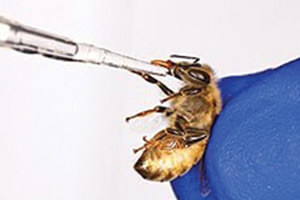
Bacteria in the gut of young honey bees may provide clues about the impact parasites have on bee health. That and other experimental findings were published by U.S. Department of Agriculture’s Agricultural Research Service (ARS) researchers in the Proceedings of the National Academy of Sciences.
Because young honey bees don’t have gut bacteria, entomologist Jay Evans and post-doc Ryan Schwarz at ARS’ Bee Research Laboratory in Beltsville, Maryland, and University of Texas at Austin professor Nancy Moran conducted tests to determine the impact different combinations of a common bacterium and a common parasite had on honey bee health. The scientists hypothesized that increasing the gut bacterium would make the bees more resistant to the parasite, but introducing a second round of parasites to those same bees lead to surprising results.
“This was 180 degrees opposite of our original hypothesis,” said Schwarz. “We suspected introduction of the bacterium would promote a resistance to the parasite, but the opposite occurred.”
Other findings from the research include,
- If the gut of the young bees were colonized by parasites and/or by an unusually large number of the gut bacterium, they would have a much different gut make-up (microbiome) in later life than normal bees.
- Bees treated with combinations of the bacterium and/or parasites showed greater key detoxification gene activity when placed in a stressed (low-protein diet) condition. This is significant as these genes affect a bee’s ability to breakdown foreign molecules, including insecticides.
- Bees with greater parasite infestations might spend more time in the hive as workers and thus increase the likelihood of parasite transmission within the colony and impact the ability of the bees to gather food.
These results highlight how shifts in the bees’ gut make-up might play a crucial role in the health of the honey bee colony.
“Beekeepers need to be more mindful of what goes into their hives whether antibiotic, probiotic, or parasite,” said ARS entomologist Jay Evans. “Eight types of bacteria usually inhabit a bee’s gut. It’s clear that more research is needed in order to gain a better understanding of these microbes and their impact on bee health.”
Pollinators are critical to the nation’s economy, food security and environmental health. Honey bee pollination alone adds more than $15 billion in value to agricultural crops each year and helps ensure that our diets include ample fruits, nuts and vegetables. As part of the National Strategy to Promote the Health of Honey Bees and Other Pollinators, USDA and other federal agencies conduct science-based research to understand and find solutions for the causes of honey bee losses, to increase pollinator habitat and raise awareness about better bee management.
USDA’s research and outreach agencies are working in many ways to contribute to the President’s National Strategy to Promote the Health of Honeybees and Other Pollinators. For example, the U.S. Forest Service is also conducting research on pollinators while restoring and improving pollinator habitat on national forests and grasslands. Over the past six years, the USDA’s Agricultural Research Service has invested more than $82 million in cutting-edge pollinator research and over the past decade has published nearly 200 journal articles about pollinators. USDA’s People’s Garden Initiative has launched a number of efforts to expand pollinator public education programs, including a bee cam that gives real time insight into the 80,000 bees who live on the roof of USDA’s Headquarters and pollinate the surrounding landscape.
The fact sheet: Research and Outreach at USDA Keeps Pollinators Buzzing contains more information about USDA’s work to keep pollinators buzzing and contributing to a diverse domestic and global food supply.


